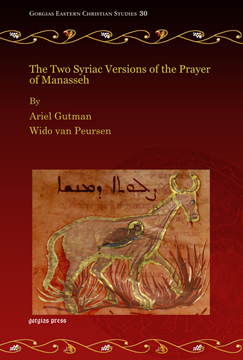Wido van Peursen
The Two Syriac Versions of the Prayer of Manasseh
Series: Gorgias Eastern Christian Studies 30
ISBN: 978-1-4632-0050-3
The authors present a detailed philological and linguistic comparison of two versions of The Prayer of Manasseh. Combing state-of-the-art computational tools together with traditional philology, the texts are compared at all linguistic levels, from their vocabulary up to their discursive structure, with a special emphasis on their morphology and syntax. The results are revealing not only for the question of the relationship between the two versions, but they also illuminate various debates pertaining to Syriac syntax.
$184.00 (USD) $110.40 (USD)
Foundations for Syriac Lexicography II
Colloquia of the International Syriac Language Project
Edited by P. J. Williams; Managing Editor Beryl Turner
Series: Perspectives on Syriac Linguistics 3
ISBN: 978-1-60724-088-4
This volume is part of a series that addresses issues of Classical Syriac lexicography, and the lexicography of other ancient languages. The international team of authors invited to participate represents a wide range of disciplines and opens new horizons in lexical thinking. Essays in this volume discuss taxonomy, the Syriac passive participle, translating Greek verbs with alpha privatives into Syriac, the translation of Syriac particles, and the history of Syriac lexica. This book represents the forefront of Syriac lexical studies, and has much to offer those studying Greek and other Semitic languages as well.
$138.00 (USD) $82.80 (USD)
Foundations for Syriac Lexicography III
Colloquia of the International Syriac Language Project
Series: Perspectives on Syriac Linguistics 4
ISBN: 978-1-60724-072-3
This volume is part of a series that addresses issues of Classical Syriac lexicography, and the lexicography of other ancient languages. The international team of authors invited to participate represents a wide range of disciplines and opens new horizons in lexical thinking. Essays in this volume discuss the place for enclitics in lexica, the grammatical classification of words, translation technique, and using new technologies to aid in the lexicographer’s task. This book represents the forefront of Syriac lexical studies, and has much to offer those studying Greek and other Semitic languages as well.
$166.00 (USD) $99.60 (USD)



